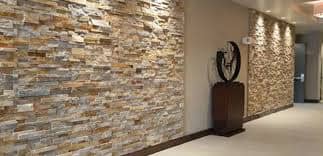Introduction
In the realm of interior and exterior design, few materials capture the timeless elegance and rugged charm of natural stone. Decorative stone wall cladding has emerged as a popular choice for homeowners and designers seeking to add a touch of sophistication and durability to their spaces. This guide aims to explore the various facets of stone wall cladding, offering insights into its benefits, types, installation processes, and maintenance. Whether you’re considering a makeover for your home or embarking on a new construction project, understanding the nuances of decorative stone wall cladding can help you make informed decisions that enhance both aesthetics and functionality.
What is Decorative Stone Wall Cladding?
Decorative stone wall cladding refers to the application of stone materials to walls to enhance their visual appeal and structural integrity. Unlike traditional stone walls that are built from the ground up, cladding involves attaching thin slices or panels of stone to a wall’s surface. This technique allows for the rich, natural beauty of stone to be incorporated into a variety of settings without the need for full stone construction.
Benefits of Stone Wall Cladding
- Aesthetic Appeal: Stone wall cladding offers a timeless and versatile look, from rustic to modern. Its natural textures and colors can complement a wide range of design styles, creating a stunning focal point or subtle backdrop.
- Durability: Stone is renowned for its strength and longevity. Stone wall cladding can withstand harsh weather conditions, making it an excellent choice for both interior and exterior applications.
- Low Maintenance: Unlike some materials that require regular upkeep, stone cladding is relatively easy to maintain. A simple cleaning routine can keep it looking pristine for years.
- Energy Efficiency: Stone has insulating properties that can help regulate indoor temperatures. This can lead to energy savings by reducing the need for heating and cooling.
- Value Addition: Properties featuring stone wall cladding often see an increase in market value due to the perceived luxury and durability of the material.
Types of Decorative Stone Wall Cladding
Natural Stone Cladding
Natural stone cladding is crafted from quarried stones and includes varieties such as granite, limestone, slate, and sandstone. Each type of natural stone offers unique colors, textures, and patterns, making it possible to create custom looks.
- Granite: Known for its strength and durability, granite cladding provides a polished, sophisticated appearance.
- Limestone: Offering a more muted and earthy look, limestone is versatile and works well in both traditional and contemporary designs.
- Slate: Slate is valued for its distinct layered texture and color variations, adding depth and character to wall surfaces.
- Sandstone: With its warm tones and rich textures, sandstone cladding can create a welcoming and natural ambiance.
Engineered Stone Cladding
Engineered stone is a man-made product that mimics the appearance of natural stone. It is composed of crushed stone mixed with resins and pigments.
- Quartz: Engineered quartz offers a sleek, uniform appearance and is available in a wide range of colors and patterns.
- Concrete: Concrete cladding can be designed to replicate the look of various stones while providing a more affordable and customizable option.
Veneer Stone Cladding
Stone veneer is a thin layer of natural or manufactured stone applied to a wall’s surface. It is lighter and easier to install than full-thickness stone, making it a popular choice for both residential and commercial applications.
Installation Process
Preparation
- Surface Assessment: Ensure the wall surface is clean, dry, and structurally sound. Any imperfections should be addressed before installation.
- Layout Planning: Plan the layout of the stone cladding to ensure a balanced and aesthetically pleasing arrangement. This step may involve arranging the stones in various patterns before affixing them to the wall.
Application
- Adhesive Application: Apply a suitable adhesive or mortar to the wall surface. The choice of adhesive will depend on the type of stone and the wall’s material.
- Stone Placement: Begin placing the stones according to the planned layout. Ensure that each stone is firmly pressed into the adhesive and that gaps between stones are consistent.
- Grouting: After the adhesive has set, apply grout between the stones if required. This step helps to fill any gaps and secure the stones in place.
Finishing Touches
- Cleaning: Clean off any excess grout or adhesive from the stone surfaces before it dries to avoid staining.
- Sealing: Depending on the type of stone, a sealant may be applied to protect the surface from moisture and stains.
Maintenance
- Regular Cleaning: Dust and clean the stone surface regularly using a soft brush or cloth. For more thorough cleaning, use a mild detergent and water.
- Stain Removal: Address any stains promptly with appropriate cleaning solutions. Avoid using harsh chemicals that could damage the stone.
- Inspection: Periodically inspect the cladding for any signs of damage or loose stones. Address any issues promptly to maintain the integrity of the installation.
Conclusion
Decorative stone wall cladding is an exceptional choice for those seeking to enhance their space with the natural beauty and enduring quality of stone. By understanding the different types of stone, the installation process, and the necessary maintenance, you can ensure that your stone cladding project is both successful and long-lasting. Whether used to create a dramatic feature wall or to add subtle elegance to a room, stone cladding offers a versatile and sophisticated solution that stands the test of time.


